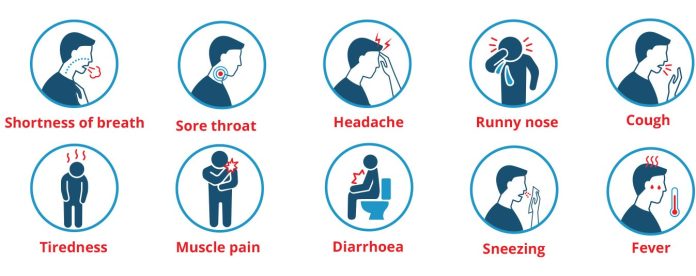A new group of COVID-19 variants are circulating, sparking concerns about a potential summer wave.
The family of variants, nicknamed “FLiRT,” after their mutations, include KP.2, which is now the dominant variant in the United States.
The symptoms of the FLiRT variants are similar to those caused by JN.1, which include:
- Sore throat
- Cough
- Fatigue
- Congestion
- Runny nose
- Headache
- Muscle aches
- Fever or chills
- New loss of sense of taste or smell
- Shortness of breath or difficulty breathing
- Nausea or vomiting
- Diarrhea
According to the CDC, the type and severity of symptoms a person experiences usually depend more on a person’s underlying health and immunity rather than the variant that caused the infection.
Laboratory studies suggest that KP.2 is mutated enough such that current vaccines and immunity from prior infection will only provide partial protection
In recent weeks, KP.2 quickly overtook JN.1, the omicron subvariant that drove a surge in COVID cases this past winter.
Currently, KP.2 accounts for one in four infections nationwide, according to the latest data from the U.S. Centers for Disease Control and Prevention.
During a two-week period ending April 27, KP.2 made up nearly 25% of cases in the U.S., up from about 10% during the previous two-week period ending on April 13. After KP.2, the next most common variant is JN,1, which accounts for 22% of cases, followed by two JN.1 subvariants, JN.1.7 and JN.1.13.1.
Low vaccination rates and waning immunity create a vulnerable population, which may allow the FLiRT variants to take hold
Another FLiRT variant, called KP.1.1, is also circulating in the U.S., but is less widespread than KP.2. It currently accounts for about 7.5% of infections nationwide, per the CDC.
Although cases and hospitalizations are down and the country is in the middle of a COVID-19 lull, the new FLiRT variants are stoking concerns about another wave of infections this summer.
Are the new variants more transmissible?
“It’s still early days, but the initial impression is that this variant (KP.2) is rather transmissible,” Dr. William Schaffner, professor of infectious diseases at Vanderbilt University Medical Center, says.
The proportion of cases caused by KP.2 is increasing while the proportion caused by other variants is decreasing, which suggests KP.2 has features that give it an advantage, the experts note.
Over 97% of people in the U.S. have natural or vaccine-induced antibodies against the the SARS-CoV-2 virus, per the CDC, but this immune protection fades over time.
Low vaccination rates and waning immunity create a vulnerable population, which may allow the FLiRT variants to take hold. Only time and more data will tell, the experts note.
Laboratory studies suggest that KP.2 is mutated enough such that current vaccines and immunity from prior infection will only provide partial protection, says Schaffner. “We’ll have to see how true that is, but it appears, over time to be becoming a more prominent variant,” he adds.
“It’s still really early in the emergence of KP.2, but I don’t think we need to sound the alarm bells as of yet,” says Ko.


